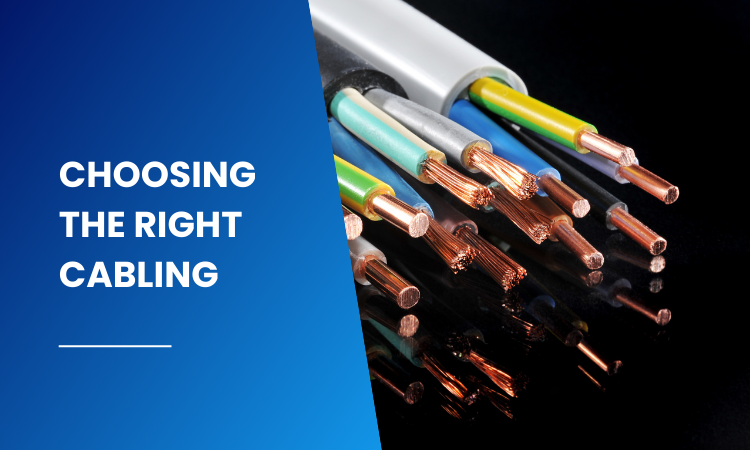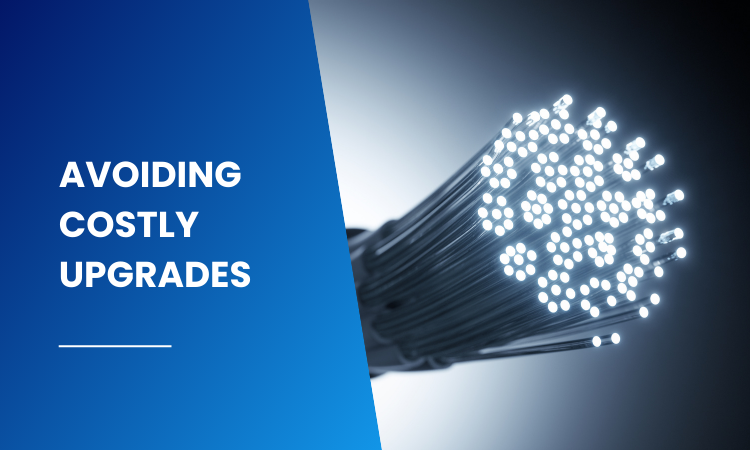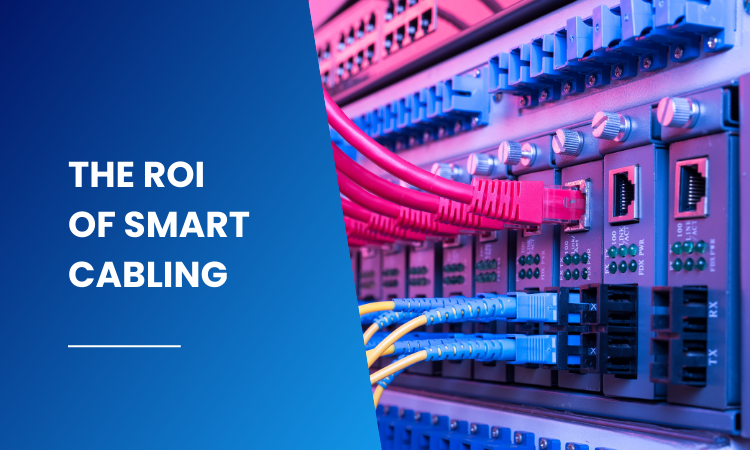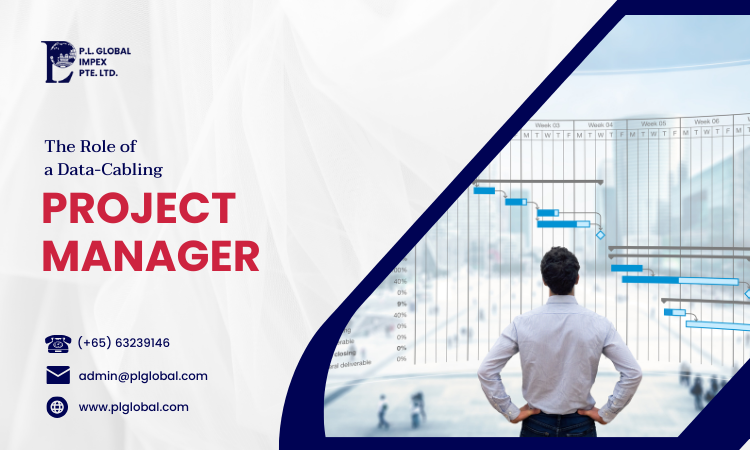Table of Contents
Introduction:
In today’s constantly changing digital world, a strong network that can be easily changed is essential for any business to succeed. But how do you make sure that your network system can keep up with your business’s growth and new technologies? The data-cabling project planner is your secret weapon for making sure your network will work in the future. This (blog) post talks about how important it is to have a data-wiring project manager to plan, set up, and oversee a structured cabling system that meets your needs now and in the future. We will talk about how their knowledge of fiber optic building, structured cabling projects, and managing a cabling plant as a whole can help you build a network that is ready for whatever the future brings.
1. Beyond Today's Needs: How a Data Cabling Project Manager Designs for Future Growth:
Are you planning to move your office or update your network? Even though your current needs are important, it’s also important to think about the future. This is where a project manager for data wiring comes in. They work with you as a strategic partner to make sure that your structured wiring project works now and can be expanded in the future.
A project manager for data wiring plans for the future in this way:
Scalability: They figure out how much data you’re using now and how much you’ll need in the future. This could mean suggesting that you add more conduit space during installation so that it’s easy to add new wires as your network grows.
Technology-agnostic Design: they put a lot of weight on future-proofing wiring standards that can work with a wide range of technologies. Installing high-bandwidth (fiber optic cables) along with standard copper cables could be one way to do this. This would give you the freedom to adapt to new technologies.
Modular Cabling Plant: The cabling plant, which is where all the network links are kept, is made so that it can be easily expanded. This means that you can easily change the layout and add new equipment as your needs change, without having to pay for expensive switching.
Collaboration with Fiber Optic Construction Companies: When it is suggested that fiber optic infrastructure be put in place, data cabling project managers work with skilled fiber optic construction companies to make sure the job is done right and that it can be expanded in the future.

2. Fiber Optics vs. Copper: Choosing the Right Cabling for Tomorrow with Your Data Cabling Project Manager:
Copper cables and fiber optic cables are the two major types of cables used in structured cabling projects. There are pros and cons to each, and making this choice can be hard. This is where your project manager for data wiring really shines.
Figuring Out What You Need:
First, the person in charge of your data cabling job will look at your specific needs. Things like cash, needed bandwidth, and data transfer speeds will be taken into account.
Fiber vs. Copper:
Copper: Copper cables are a traditional and inexpensive choice for short lengths and average data transfer speeds. On the other hand, interference and communication loss can happen over long distances.
The Fiber Optic: These lines are made of glass or plastic fibers and send data through light pulses. They have a much wider bandwidth and don’t get messed up by other signals. They work great for sending info over long distances and at high speeds.
Choosing the Right Thing:
The person in charge of your data cabling project will use their knowledge to help you choose the best choice for your needs. Here’s a general rule of thumb:
Copper cables might be enough for shorter distances and smaller bandwidth needs.
Fiber optics is the best way to make sure your network will work in the future, send data quickly, or connect over long distances.
Working together with companies that build fiber optics:
Your data cabling project manager will work with qualified fiber optic building companies if your project needs fiber optic infrastructure. This makes sure that the installation goes smoothly and fits in with your general structured cabling plan.
When you work with a data cabling project manager, you can use their knowledge of both copper and fiber optic systems. They will help you pick the best cabling option for your needs now and in the future, making sure your network is ready for anything that comes up tomorrow.
3. Scalability & Flexibility: A Data Cabling Project Manager's Plan for Network Expansion:
The needs of your network will change as your business grows. A (project manager) for data cabling doesn’t just put in wires; they also plan a structured cabling system that can be expanded and changed as needed. This will make sure that your network can easily grow in the future, which will save you time, money, and stress in the long run.
Getting ready for growth:
Checking for Needs: A project manager for data wiring will work with you to figure out how you use your network now and how you think it will grow in the future. This helps them come up with a system that can handle more gadgets and more bandwidth.
Strategic Layout of Cabling: They plan the paths and locations of your cables in your building in a way that makes sense. To make room for future cable additions, this might mean adding more conduits during the initial building.
Modular Design for the Cabling Plant: The cabling plant, which is the hub of your network, is built with flexibility in mind. As your network grows, this makes it easy to change how the equipment and patch panels are set up, so you don’t have to pay for expensive switching.
Standards for Scalable Wiring: Standards for future-proof wiring are favored so they can work with more technologies. This might mean putting in high-bandwidth fiber optic lines along with copper ones. This would make it possible to upgrade the network in the future.
Why a scalable cabling plan is good:
Cost Savings: If you plan ahead for your business’s growth, you can avoid having to pay for expensive network overhauls or rewirings in the future.
Less downtime: If you plan your cabling system well, it will be easier to update your equipment and add more users to your network, and it will not affect your daily operations too much.
Network Ready for the Future: Your network is ready to handle more data flow and new technologies, which will help your business stay ahead of the curve.

4. Future-Proofing Your Budget: Avoiding Costly Upgrades with Smart Cabling Design:
Every dollar counts in business these days. When it comes to your network equipment, not planning ahead can cost you a lot of money. This is where a project manager for data wiring saves you money. They can help you protect your budget for the future by planning a structured cabling project that keeps you from having to make expensive changes in the future.
Tips for Designing Smart Cabling:
Planning for Scalability: A project manager for data cabling will look at your present and future needs. After that, they plan a wiring system that can handle the expected growth. This could mean adding more room for conduits during the initial construction, so there is no need for disruptive and pricey expansion projects in the future.
Technology-Agnostic Design: Putting future-proof wiring standards at the top of your list of priorities will help your network adapt to new technologies. Installing high-bandwidth fiber optic cables along with standard copper cables, for example, lets you make upgrades in the future without having to completely rewire.
Modular Cable Plant: The cable plant, which is the hub of your network, is made so that it can be expanded in different ways. This makes it easy to change the layout and add new equipment as your needs change, without having to pay to rip out and replace the cables.
Avoiding Overspending: Data-cabling project managers can help you avoid spending too much on features that you don’t need. That way, you won’t be sold more capacity than you need, because they will only suggest cabling options that meet your unique needs.
The Savings for the Long Term:
If you buy a structured cable system that is well-designed, you’ll save a lot of money in the long run:
Lower Costs for Upgrades: As your business grows, you won’t have to spend as much on expensive network overhauls if you use a plan that is flexible.
Less Downtime: A modular cabling plant makes it easier to upgrade equipment and add to a network with little downtime. This lowers the cost of lost output.
Lower Maintenance Costs: A well-designed and future-proof wiring system costs less to maintain and fix problems over time, which saves you money in the long run.
Lower Maintenance Costs: A well-designed and future-proof wiring system costs less to maintain and fix problems over time, which saves you money in the long run.
5. Emerging Technologies & Your Network: How a Data Cabling Project Manager Prepares for the Unknown:
Technology is always changing, and so do the things we need from our networks. It’s hard to know what will happen in the future, but a data-cabling project manager can help you get ready for what might happen. When they create structured cabling projects, they make sure that they are flexible so that your network can keep up with the needs of new technologies.
Strategies for the Future:
Compatibility and Standards: Data cabling project managers make following industry-standard cabling practices a top priority. These guidelines make sure that your network can handle a lot of different technologies, both now and in the future.
Scalability and Flexibility: The wiring system is made so that it can be expanded as needed. To do this, you need to be able to handle more data flow and quickly add new equipment or cables as needed.
Fiber Optic Infrastructure: Fiber optic lines have the widest bandwidth and are less likely to get messed up. Your data cabling project manager makes sure that your network can handle fast data transfers by working with and offering qualified fiber optic construction companies for installation. This is a key requirement for many new technologies.
Flexible Cabling Plant Design: The cabling plant, which is the hub of your network, is made to be flexible. This makes it easy to change the way the network is set up and add new devices as new technologies come out, so the network doesn’t have to be redone from scratch.
Advantages of Planning Ahead:
Future-Ready Network: Your network is ready to handle the needs of new technologies that come out of the blue, so you don’t get left behind.
Less Downtime: A modular cable plant makes it easier to add new technologies while causing as little trouble as possible to your daily operations.
Increased ROI: If you invest in flexible cable, you can avoid the high costs of upgrading your network often, which will help you get the most out of your money.

6. The Data Center of Tomorrow: A Data Cabling Project Manager's Vision:
The data center is very important because data is still the heart of modern businesses. But what will tomorrow’s data center look like? A data-cabling project manager doesn’t just think about what’s needed now; they also think about what will be needed in the future. Here’s how they go about building a data center that will work well for years to come.
Efficiency and the Ability to Grow:
High-Density Cabling: Project managers in charge of data cabling use high-density cabling options to make the best use of space in the data center. This makes it possible to pack equipment efficiently and add on in the future without affecting efficiency.
Modular Design: The equipment for the cables is made so that it can be used in different ways. This makes it easy to change how power and cooling systems are set up when new technologies come out that need different amounts of power.
Fiber Optic Backbone: The backbone of the network is made up of fiber optic cables, which offer unmatched bandwidth for fast data transfer and will help cloud computing and data storage options get better in the future.
Collaboration:
Partnering with Fiber Optic Construction Companies: Data cabling project managers work with qualified fiber optic building companies to build the best fiber optic infrastructure. This makes sure that the installation goes smoothly and fits in with the plan of the whole data center.
Keeping Up: They are always aware of new developments in data center technology, like how (artificial intelligence) can be used to improve power and cooling control.
The Pros of a Data Center That Can Handle the Future:
Reduced Costs: If your data center is flexible and works well, you won’t have to pay as much for improvements and expansions in the future.
Increased Capacity: Your data center will be able to handle growing data storing and processing needs as long as it is easy to add new equipment and cables.
Better for the Environment: modular design lets power and cooling systems work better, which lowers the impact of the data center on the environment.
7. Standardization & Compatibility: Ensuring Your Cabling Plant Adapts with a Data Cabling Project Manager:
These days, technology changes very quickly, so it’s important to make sure your network system can keep up. A data-cabling project manager can be very helpful at this point. They don’t just place cables; they plan structured cabling projects with standardization and compatibility in mind. This will make sure that your cable plant, which is the heart of your network, can continue to work with new technologies and tools for many years to come.
Standardization’s Power:
Norms for the Industry: Following industry-standard wiring rules like TIA and EIA is very important for people in charge of data cable projects. These rules explain the different kinds of cables, how to place them, and how to label them. This keeps a lot of different network gadgets, both current and future, from not working with each other.
Record keeping and Labeling: It is important that all cables and connections in the cabling plant have clear and uniform labels. The person in charge of your data cabling project will set up and strictly enforce a labeling system. This will make it easier to find and handle future changes or additions to the network.
Getting Ready for Flexibility:
Building in Modules: Modularity was taken into account when the cable plant was planned. In this case, you should use patch panels and other parts that make it easy to change the way your network is set up and add new equipment or cables as your needs change.
Choices for Cabling That Will Last: Managers of data cabling projects put future-proof cable choices at the top of their list. Installing (high-bandwidth fiber optic cables) along with standard copper cables could be one way to do this. This would make it easier to add new technologies that need faster data transfer speeds.
Why Standardization and Compatibility are Good:
Less downtime: If changes or improvements need to be made, a standard and well-documented cabling plant makes it easier to reconfigure, which cuts down on network downtime.
Easy Maintenance: Troubleshooting and maintenance are easier and faster when parts are clearly labeled and standardized.
Forward-Looking Network: If you follow industry standards and use future-proof cabling options, your network can better adapt to new technologies, making sure it stays compatible and works.

8. Avoiding Future Headaches: Preventative Maintenance Strategies from Your Data Cabling Project Manager:
Imagine a time when network problems are a thing of the past. An ideal world where your network always works well. You can make this perfect world come true with the help of a data-cabling project manager. Not only do they plan and set up structured wiring projects, but they also do preventative maintenance with you to make sure your network keeps running at its best for years to come.
Maintenance Strategies:
Regular Check-ups: The person in charge of your data cable project will suggest a regular check-up schedule for your cabling plant. This means looking for things like loose connections, broken cables, and good dust control. Finding possible problems early on keeps them from getting worse and causing major network disruptions.
Watching over the Environment: It is important to keep an eye on things like temperature and humidity in the wiring plant. Your (project manager) for data cabling can help you find the best monitoring tools to make sure that your cables and equipment are in the best possible setting.
Label Check: Labels on cables can fade or come off over time. All the wires and connections in the cabling plant can be easily found thanks to regular checks and, if necessary, new labels. It will be easier to fix problems and do upkeep in the future.
Training & Awareness: Teaching your employees the right way to handle cables can help keep them from damaging them by mistake. The person in charge of your data cabling project can make training programs or give you tools to help people learn more about the best ways to use network equipment and cables.
Preventative Maintenance has these Pros:
Reduced Downtime: If you deal with possible problems before they happen, you lower the chance that your network will go down and your business will be interrupted.
Longer Equipment Life: If you do regular repairs on your cabling infrastructure, it will last longer and last longer, saving you money on expensive replacements in the future.
Better Network Performance: Maintenance checks make sure your network works at its best, which means faster data transfers and a more stable experience for users.

9. Future-Proofing for Efficiency: A Data Cabling Project Manager Optimizes Network Performance:
Nowadays, when everything is digital, network speed is very important. Slow or unstable networks can make it hard to get work done and stop businesses from growing. But what if you could make sure that your network is not only perfect for now but also works perfectly for years to come?
For this, a data-cabling project manager is needed. It’s not just installing cables for your structured cabling jobs; they do more. They develop and install cabling solutions that improve network performance over time as efficiency architects.
Optimizing for Efficiency:
Scalability and Planning: Your current network usage and how it will grow in the future are both looked at by a data-cabling project manager. Afterward, they create a wiring system that can handle more data without slowing down. Depending on the situation, this could mean using high-density cabling options or adding more conduit room during the development phase.
Strategized Cabling Layout: It’s important to carefully plan the paths and locations of your cables inside your building. These steps might include keeping cable lengths as short as possible for best signal strength and making sure that power and data lines are properly separated to avoid interference.
Integrating Fiber Optics: Fiber optic lines are a game-changer for sending data quickly and with little signal loss. For proper network integration, data cabling project managers can suggest and work with qualified fiber optic building companies.
Modular Cabling Plant Design: The cabling plant, which is the hub of your network, is manufactured with flexibility in mind. So, as your network needs change, it’s easy to rearrange equipment and patch panels, keeping data flowing smoothly and preventing jams.
Advantages of Improving Network Performance:
User Experience Improvements: Employees will be more productive and efficient at work if the network is fast and data can be sent more quickly.
Less Downtime: Correctly installed cables lower the chance of network problems and interruptions, which keeps your business working smoothly.
Lowered Maintenance Costs: A well-designed network needs less regular upkeep and fixing of problems, which saves you money over time.

10. The ROI of Smart Cabling: How a Data Cabling Project Manager Saves You Money in the Long Run:
Every business choice has to explain why it’s worth the money. When it comes to your network equipment, it might seem like a good idea at first to choose the cheapest option. A data-cable project manager, on the other hand, can show how smart cabling design leads to a big return on investment (ROI).
Long-Term Costs vs. Short-Term Savings:
How to Avoid Expensive Upgrades: Scalability and future-proofing are important to a data-cabling project manager. They plan a structured cable project that can grow with the business. This way, they don’t have to pay for expensive network upgrades in the future.
Less Downtime: A well-designed cabling system makes it easier to improve equipment and add more users to the network with little trouble. This means that less money and work time will be lost.
Minimized Maintenance Costs: Upkeep costs are kept to a minimum when you have a well-planned and future-proof cabling infrastructure. This is because it needs less ongoing upkeep and troubleshooting, which saves you money on technician fees and replacement parts.
Data Cabling Project Manager: Your Financial Partner:
Smart Choices for Cabling: Data wiring project managers help you find solutions that are perfect for your needs, so you don’t end up spending too much on features or cables that aren’t needed.
Collaboration and Knowledge: They work with qualified fiber optic building companies to make sure that your budget doesn’t get in the way of getting the best fiber optic integration.
Protecting your Network for the Future: If you buy a well-designed cabling system, you won’t have to pay a lot of money for regular network upgrades. This will help you get the most out of your investment over the life of your network.
The True Value of Smart Cabling:
Working with a data-cabling project manager has many perks besides just saving money right away. They build a network system that is reliable and flexible that:
Helps a Business Grow: Your network can easily grow as your business does, so you don’t have to pay for expensive overhauls as you go.
Reduces Disruptions: Smart cabling design reduces downtime during repair and upgrades to the network, which keeps the business running.
Makes the User Experience Better: A well-run network means faster data sharing and a more productive workplace for your staff.
Conclusion:
When you work with a data-cabling project manager, you invest in a network that will be able to handle the needs of the future. Their knowledge of structured cabling projects, from picking the best fiber optic building companies to making a cabling plant that can be expanded, makes sure that your network stays strong and supports your business’s growth. Do not wait for your network to become old; plan ahead and get in touch with a data-cabling project manager right now.



